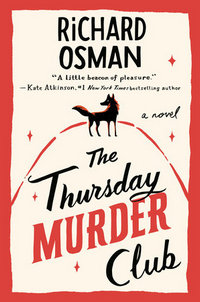 |
The Thursday Murder Clubby Richard Osman Hardcover, 351 pg. Read: February 22-23, 2021 |

“So, we were all witnesses to a murder,” says Elizabeth. “Which, needless to say, is wonderful.”
What’s The Thursday Murder Club About?
Britain’s first seventh “Luxury Retirement Village,” Coopers Chase is built on the remains of a Roman Catholic convent. On Thursdays, the Jigsaw Room is booked for “Japanese Opera: A Discussion,” during the two-hour slot between Art History and Conversational French. This isn’t actually what happens then, but it’s a great way to dissuade people from dropping in.
What actually happens is that a group of four residents get together to look over cold cases and see if they can make any progress with them. One of the group’s founders was a detective in the Kent Police, and it’s her cases they started going through. When necessary, or when the opportunity presented itself, they’d bring in various experts to consult. Shortly before the book opens, they’d had a change in membership, the former detective’s health had put her in the hospital ward, and when they’d asked a retired nurse for some input, she’d been curious enough to attend the meetings.
At that point, the roster consisted of a socialist activist of some renown, a retired therapist, and a well…we’re never told precisely what Elizabeth did, but The Official Secrets Act and a lot of foreign travel was involved.
Then one of the owners of Coopers Chase, the man who did the actual building, is murdered. Suddenly, they’re not that worried about cold cases, when they have a current case to help the police with (whether the police want/need their help isn’t a consideration).
How the Story is Told
Primarily, the book is told from a variety of third-person perspectives—focusing on most of the Club, a police constable, a Detective Chief Inspector, and others involved in Coopers Chase. It’s a great way to tell this story, you get to know all the characters, see everything going on, and get a real feel for this world. But what makes this better—what helps the reader get into this world, is the retired nurse, Joyce. As she gets into the Club as a whole, and especially as she becomes friends with Elizabeth (in less charitable moments, you might say she’s becoming Elizabeth’s sidekick—and I’m not certain Joyce would mind that), she starts keeping an electronic diary, and Osmund will insert an entry between chapters as a way of breaking up the text and helping the reader to focus on certain elements of the third-person narration.
Through this diary we see her joy in finding something to do, in making friends, in pursuing a romance, in skirting trouble with the police. It’s not really clear how involved Joyce was in the overall Coopers Chase community until this case, but this gives her a spark and opens new worlds and possibilities for her, and it’s heart-warming (at least) to read the progression of this. I will say, in bed with limited light, the typeface that is used for her diary entries (at least in the American Hardcover) wasn’t that easy for me to read—but it was absolutely worth the effort.
Initially, that’s all I wanted to talk about, but I realized the other way to interpret “how” could use some discussion. Osman writes with warmth, gentle humor, heart, and charm. Joyce’s diaries are delightful and the this-person narration is close to that, too. This is a book of dark things—murder, secrets, depravity, scandal, declining health, dementia, grief, loneliness, and death are everywhere. But there’s also community, friendship, and hope—and those latter three so characterize the book that the darkness seems surmountable and something you can be carried through because of the warmth and community. It’s hard to pull that off while being honest about the human condition—but Osman pulls it off with aplomb.
A Pond’s Worth of Red Herrings
I don’t remember the last time I read a mystery novel so full of red herrings—in terms of clues or viable suspects. I loved that—sure, some were easy to spot as being a red herring. But more than once I had to admit to myself that Osman had fooled me.
I love a smart mystery, one that makes me think, one that tricks me (without cheating too much), one that surprises me—and that’s exactly what we get here.
So Many Confessions
Part Two of the novel is called, “Everyone Here Has a Story to Tell,” and man, is that descriptive. There are, by the time all is said and done, several criminals in this book—and some people who aren’t criminals, yet carry a terrible weight of guilt (both deserved and not). And we get all of their stories—sometimes through the narration, but largely from their own dialogue. Secrets are laid bare—primarily for the Club and the reader, but some for a larger audience. Not all of them help anyone get closer to the killer (killers?)—but they all help tell the story.
Some confess because they’ve been waiting for the opportunity (as well as dreading it), some because they’ve been forced into it, some because it just doesn’t matter anymore. Ultimately, it doesn’t matter why they do it, only that they do.
So, what did I think about The Thursday Murder Club?
It is this kind of thing that keeps me reading Crime Fiction—as much as I might read police procedurals and PI (or PI adjacent) novels by the handful, you give me a clever assortment of characters doing interesting things and getting results from a combination of work and smarts and I’m in hog heaven.
A moment ago, I mentioned the title of Part Two. Part One is called, “Meet New People and Try New Things.” For Joyce and Donna (the Police Constable), that’s plainly what this book holds—Donna’s first homicide case and something that puts a spring in Joyce’s step and a twinkle in her eye. But it’s actually true for just about all the characters, and who doesn’t like the idea of a group of septuagenarians (give or take a couple of years) having new experiences to try?
On the off-chance my mother reads this in the next couple of days, I’m going to spoil her birthday and tell her that this is going to be waiting for her on her e-reader. I mention this publicly to illustrate how much I like this book—while I still had over one hundred pages to go, I was already planning on getting it for her (unless the ending was a mess).
A smart mystery, told well, with characters that are just as smart and well-told. I can’t think of a thing about this novel I didn’t like—it was touching, amusing, honest about the circumstances that these characters found themselves in, but life-affirming, too. There’s a lot of profundity mixed in with the amusement—and a clever mystery, to boot! This is not one to pass up.


This post contains an affiliate link. If you purchase from it, I will get a small commission at no additional cost to you. As always, opinions are my own.
![]()


wittysarcasticbookclub
Ooh, I bought this one a bit ago– moving it up the tbr. Great post!
HCNewton
Thank you!
I think you’ll dig it.